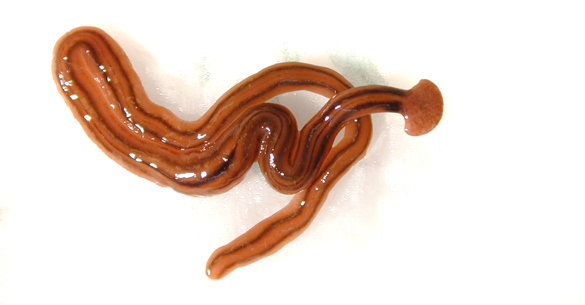Land planarians are one of the more unusual and interesting creatures in and around greenhouses and gardens. One of the most common Texas species is Bipalium kewense. This animal belongs to one of the most primitive animal groups, the Phylum Platyhelminthes–also known as flatworms. Originally from southeast Asia, this species has been dispersed by man to more than 50 countries around the world.
Bipalium kewense is recognized by its flattened head and longitudinal stripes. It is also one of the largest flatworms, reaching lengths of up to 25 cm (10 inches). It is a slimy animal, well endowed with mucus glands in its skin. It is even capable of hanging from leaves or branches by a string of mucus. Terrestrial flatworms are predators, and locate their prey through a process called chemo-sensation. Eggs are laid in capsules, and hatch as small worms.
Like flatworms of biology textbook fame, land planarians can also reproduce by dividing into fragments. They are not harmful to people and make interesting subjects for science fair projects on chemical smell and regeneration. In areas where they have become established, they can be collected on the surface of moist soil, or are sometimes seen on sidewalks after a rain.
Most terrestrial (non-aquatic) planarians in North America are exotic, having arrived here via the trade in potted foliage plants. Although land planarians do not attack plants, they are predators of earthworms, a fact that has raised concerns among some biologists. Unfortunately, little is known about their distribution, ecology, or true impact on earthworms in Texas.
Control
No control for flatworms is available or recommended at this time. Avoid transferring infested potting soil or garden soil to uninfested sites. Suspected potting soil should first be heat sterilized before being used or transported.
For more information
For more information about terrestrial flatworms see the book, Living Invertebrates, by V. Pearse, J. Pearse, M. Buchsbaum and R. Buchsbaum, 1987, Blackwell Scientific Publications.
Authors
Michael Merchant, Ph.D., Professor and Extension Urban Entomologist, Texas AgriLife Extension Service
Mary Wicksten, Ph.D. , Professor, Department of Biology, Texas A&M University
